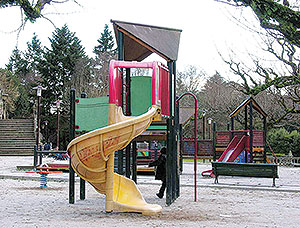
Developing stimulating play areas for kids is an important priority for parents and community leaders, according to author Mike Lanza.
By Izak Shapiro
On Tuesday, March 19, over 60 people, mostly Somerville residents, gathered in the Aldermanic Chambers at City Hall to discuss how to find safe spaces for Somerville’s children to play, and to unite.
The catalyst for the discussion was Mike Lanza, Stanford graduate, California native, father of three, and author of “Playborhood: Turn your Neighborhood into a Place for Play.”
In his book, Lanza writes that today’s children, due to high daily rates of digital consumption, overly structured days by children’s authority figures (schools, after-school, sports, family), and the tendency of families towards privacy, have far fewer safe play spaces where they, not any authority figures, can determine how, where, and when to construct and perform their preferred forms of play. Not only does Lanza tie this trend to increasingly rising rates of childhood obesity, anxiety, and depression, he also refers to a larger problem of a childhood-developed reliance on exterior motivation versus finding one’s own inner motivation, and developing one’s own life passions and goals.
Ideally, children need to have spaces in which they have control of the play in order to develop essential life skills. That’s where the adults come into play.
“Somerville has the assets to re-design our public play spaces,” said mayor Joseph A. Curtatone. “The craziest ideas are usually the most helpful.”
Somerville may truly require some crazy ideas since finding safe spaces where kids can wriggle out from under the shadow of authority can be like finding a unicorn in Davis Square.
Most of those in attendance were Somerville parents, so Lanza had each person fill out a sheet listing the most common barriers they found to establishing a safe play space. Of those who responded, 64% listed car traffic as the number one barrier. Concerns over bonds with neighbors and dealing with the social stigma of outwardly creating a play space where there was not one previously were the other top barriers for those in attendance.
The bonds with neighbors and the stigma concerns can be overcome with confidence and perseverance; traffic presents a more immovable barrier, according to Lanza.
Lanza insists children have three main places in their social lives: the family, the school, and then the informal hangout. He claims the third space has become both more virtual (internet, television, videogames) and more private (bedroom, family room, or even if time is spent outside, it’s in the backyard) with this current generation of young children; and those in attendance, the majority of whom were Somerville mothers, nodded in agreement with the author.
“We need to make it a compelling place with action,” said Lanza, who emphasized it all starts at home. “Kids 8-18 average eight hours of digital consumption a day.”
That traffic problem, though, with Somerville’s high population density, presents a unique challenge, and thus usually results in unique solutions.
“We actually have lots of spaces,” said one Union Square resident in reference to the multitude of playgrounds in the area. “It’s a matter of getting the kids there.
Discussions of email list servers, park get-togethers, and walk to school coordination quickly evolved amongst the residents in attendance.
Some city programs have already taken action. The Somerville library has a Dean’s room that older Somerville students use as that essential third space for informal organization.
Check out the Shape Up Somerville website, where you can find health programs and bike and park maps for Somerville children; Shape Up Somerville will also be starting a “walking school bus” program to ensure physical activity for students.
It was determined that Somerville’s unique population demographics and traffic density requires increased creativity and commitment from all. The city’s official department heads will meet to discuss the results of this meeting, yet they can only do so much. As discussion coordinator and SomerPromise leader Stephanie Hirsch said to conclude the meeting: “It’s all about our own leadership.”












Reader Comments